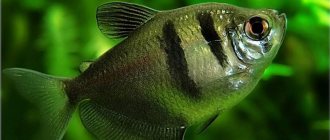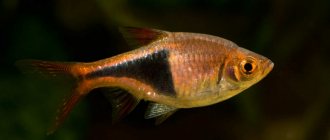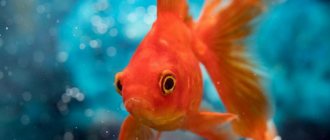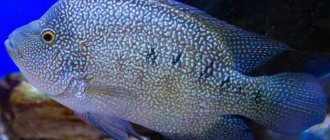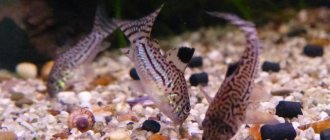Description and natural habitat
The aquarium fish Cichlazoma comes from the warm waters of America, Asia and Africa. Scientists introduced it to lovers of home ponds at the end of the century before last.
Cichlazomas belong to the class Cichlids and are predators or omnivores. They have a powerful and fairly large body (up to 20-40 cm in length), high in the dorsal fin and somewhat flattened laterally.
These are typical bottom dwellers; they also love thickets of aquatic plants and partial shade. They choose bodies of water with a slow flow, usually with a silted bottom.
The high vitality and unpretentiousness of these underwater inhabitants makes their reproduction possible not only in the natural environment, but also in cichlids.
The fins of fish end in sharp tips (they are ray-finned), but can vary in shape depending on the variety. Males are usually significantly larger than females in size and brightness of color. As a rule, monogamous, an established couple can delight their household members with their beauty and excellent behavior for many years (up to 15 years).
Photo gallery of cichlaz:
The eyes of cichlases are very expressive, large, and black. A large mouth, voluminous gills, dense leathery cover and powerful scales, a muscular strong body with a strong spine are all distinctive features of this family.
The scales adhere so tightly to the skin that parasites can almost never get under them. This is another explanation for the resilience of fish. The integument is restored so well that wounds and abrasions received during hunting or mating games heal very quickly. The color of scales and fins can be varied (depending on the species), but turquoise and steel tones, dark stripes and spots predominate more often.
Varieties
Astronotus is divided into species, among which there are three main ones: tiger, red astronotus and albino species. Based on these main types, new species still appear through crossing, such as lemon, golden and yellow astronotuses. The albino species is also the result of breeding work.
Astronotus has a brindle coloration with crimson or orange spots on a gray body. An albino has red eyes against a white body with red patches.
The breeding work called “astronotus red oscar” is distinguished by its unusual brick-colored body with black fins and is considered one of the most beautiful color variations of astronotus. The red oscar has become famous for its rich red color and this species looks impressive in the aquarium, swimming majestically in it.
The veiled astronotus, which has long beautiful fins, has an unusual and attractive appearance. As a result of breeding work, new breeds were developed, such as the blue and walnut Oscar.
Mr. Tail recommends: species of cichlases
So far, the existing gradation in the aquarium industry makes it possible to classify cichlases into one family. There are many scientific classifications, but it is more interesting to simply describe the varieties that are most popular among lovers of home artificial reservoirs.
Black-striped cichlazoomas
Very popular in modern aquarium hobby. These are small perch-like fish with bright colors and a rather calm character. They are capable of aggression during the period of spawning and caring for offspring, so it is still better to keep them in a cichlid with other representatives of their family. These can be parrots, pseudotropheus, barbs, gourami, swordtails, thornets.
The name Cichlasoma nigrofasciatum includes two words, nigro - white and fascia - black, this fish is often called zebra.
It is considered a small fish, in nature its size is about 15 cm, in an artificial reservoir it is somewhat smaller.
The main color background is grayish-bluish, with wide, alternating white and black stripes on it, which really makes the fish look like a zebra.
Males are much larger than females, they are distinguished by the pointed shape of their anal and dorsal fins, and during the spawning period a bright red stripe is visible on their belly.
Diamond cichlazomas
These cichlids really resemble a diamond due to the iridescent large scales and silvery spots evenly scattered throughout the body, even on the fins.
Body length reaches 15-17 cm, males are larger.
This cichlid is also very popular, in second place after the black stripe. Cichlasoma cyanoguttatum is also called pearl cichlasoma and Texas cichlasoma.
These fish are also quite peaceful for predators, although they are prone to fighting for territory.
Cichlazoma Severum
A very bright cichlasoma with a yellowish body, on which small orange specks are scattered, although in nature the color is completely different - grayish-greenish. But in aquariums only selected varieties are found, but they are also rare.
Sometimes it is called false discus because of its color. Whether these fish belong to the genus Cichlasom or Heros has not yet been fully determined.
In addition to the above-described “red pearl severum”, the decorative forms “blue emerald”, “red-headed”, “golden”, and many others are also in demand.
This variety of cichlases is highly aggressive, especially intraspecific. It is better to keep them separately in several pairs in a very large tank with proper zoning.
Cichlazoma Meeka
Another fairly popular species of aquarium cichlases comes from Guatemala and Southern Mexico.
The body length of the fish, painted silver on top, is 14-15 cm. Larger males have bright red spots on the belly and the lower part of the large head. The sharp fins are colored gold or have a purple tint.
Typically, these underwater inhabitants behave calmly in the aquarium, but defend their territory, so the tank should be divided into spacious zones.
Cichlasoma meeki in the wild is much larger in size, up to 35-40 cm. The fish is named after the American ichthyologist Meeki, who discovered this species of perciformes in 1933. Sometimes it is called mask because of the peculiar color of its head.
In the aquarium, Meeks usually behave slowly, but they completely transform during the mating season. At this time, it is better to house the couple separately. They love to rummage in the sandy bottom, picking out algae and turning over parts of the decorations.
Lionhead cichlazomas
They differ from other species of cichlids by a large knob-like growth above the upper part of the huge head.
Steatocranus casuarius's style of movement in a reservoir is strikingly different from the leisurely Meeks; it seems that the fish is jumping and galloping along the bottom, where it spends most of its time.
A monogamous couple usually inhabits its own cave, where it breeds offspring. It is not recommended to keep more than three families in one, even a large aquarium.
The color of the scales is usually dark with a bluish, purple or almost black tint, but gray-silver individuals are also found.
Cichlazoma Flamingo
These predatory fish are slightly smaller than their family members - from 8 to 14 cm in length. The name was given because of the unusual pinkish color, which can be very pale or more saturated. The most peaceful of all known species of cichlases.
Ichthyologists have still not agreed on the origin of this species. Some consider it to be an albino form of the black-striped cichlid, but this can hardly be true (the eyes are not red, there is pigment in the color). Others believe that the rare shade of scales is the result of a natural mutation.
Rainbow cichlazomas
One of the largest species of cichlids, even in an artificial reservoir some individuals reach 20 cm in length.
The coloring of the scales contains many bright colors - yellow, green, red, blue, which gave rise to the name of the variety.
The fish is very aggressive. Usually, one pair is selected from 6-8 individuals and moved into a separate tank. Even when zoning an aquarium, fights between males are inevitable.
Cichlazomas Bees
These perch-like fish are small in size (8-10 cm) and in nature are more often found in the Amazon River basin.
They have a very unusual and remarkable color. Each scale has a blue spot, which, when refracted in light rays, gives a unique play of colors - gold, black, azure.
Other names for the species are eight-banded, cichlazoma Biocelatum.
The brightest color is found in yearlings. Juveniles are paler and calmer. And adult males do not get along with almost anyone; it is better for the pair to be kept in a separate aquarium.
Cichlazomas Labiatum
They are distinguished by their uniform yellowish-pink color and high intelligence. If a person approaches the tank, they follow him with their gaze and even beg for food. At the same time, their neighbors in an artificial reservoir are usually completely ignored.
The large head ends in a large, well-defined mouth, which is why Labiatum is often called the big-lipped cichlazoma.
Nicaraguan cichlizomas
Large underwater inhabitants (20-25 cm in length) with a large convex head and low lips.
The color is usually a mixture of three colors - a silver body, a bluish upper part and forehead, and a purple belly.
Sedzhik's cichlazomas
A small aquarium fish (10-11 cm), peaceful, even timid in nature, there must be caves and grottoes at the bottom for shelter.
The light brown, flat and round tall body is equipped with yellowish fins. Dark wide stripes cross the body.
This species has a pronounced habit of defending its territory, especially during the mating season. It is better to keep the pair in a small (about 50-100 l) own tank.
Smaragd cichlazomas
They are very different in their behavior from other cichlids. They can be called benign neighbors rather than dangerous territorial predators.
If the wine cichlid gets scared of something, it freezes and falls to the bottom, resembling a fallen leaf. This is facilitated by the peculiar coloring of the body (yellowish, pinkish, gray tones), it helps the fish to mimic.
At the bottom of an artificial reservoir where this species of cichlids is kept, there should be shelters - grottoes, caves, dark algae. It is better to choose brown soil, then the fish Cichlasoma temporale crassa will not be stressed.
Citron or lemon cichlazomas
They are considered excellent intercalary specimens due to their bright orange light coloring and forehead-shaped head.
They usually behave calmly in the aquarium, somewhat more aggressively only during the mating season and when the tank is overpopulated. Cichlasoma citrinellum are omnivores and do not refuse live, dry and plant food. They can even eat zucchini and watermelon.
Cichlazomas Menonuata
Shy and peaceful, they can even get along with angelfish. They can jump out of a pond out of fright.
The color of the body is dull, pale yellow; a black oblique stripe runs along the body from the pectoral fin in the middle of the dorsal fin.
Cichlazoma Salvini
Cichlasoma salvini originates from the central part of the American continent. The main background of the body is greenish or brownish-yellow with bright black stripes along the entire upper half and a red belly (in males).
The fish are quite peaceful, but can defend their territory; zoning of the aquarium is necessary. Body length is from 13 to 16 cm.
Cichlazoma Spilurum
The gray cichlasoma Cichlasoma spilurum has a large body, painted in a grayish-metallic color with pale transverse stripes and retracted dorsal and ventral fins.
Quite calm, but during spawning they can become very nervous, and aggression is possible.
Cuban cichlises
Cichlasoma tetracanthum or Tetracanthum in natural conditions lives in calm waters of Cuba and Barbados.
The main background of the body is grayish-silver. Strokes and spots of black color are scattered across it. The drawing, in spite of everything, is not repeated, it is unique.
Very dangerous and aggressive, suitable only for keeping as a pair in a species aquarium. Large ones - about 20-25 cm.
Cichlazomas Fascetum
Cichlasoma facetum or Chanchita comes from reservoirs in Brazil, Honduras, Uruguay, and Argentina. The colors are varied - grayish-yellow, bluish, green, red tones. The transverse stripes are pale and extend throughout the body.
Small, but very aggressive, this is a territorial species (protecting its living space).
Managun cichlazomas
Parachromis managuensis is a very powerful and beautiful fish with an unusual black and gold color and a unique shape of fins, which is why they received their second name - Jaguar. The body length of these underwater inhabitants of aquariums is large - up to 35-40 cm.
A tank of at least 500 liters is suitable, and preferably a large one, since the fish are aggressive and always make very sharp leaps when moving.
Eliot's Cichlazomas
They are somewhat reminiscent of Meeks in color and behavior, but the red spot on the belly is brighter.
Cichlazomas Golden Leopards
This is an endemic species of African Lake Malawi. Large fish (25-30 cm) prefer bottom habitat and are able to live at depths of up to 25 m.
Because of their unique body coloring—large black spots on a lemon background—they are often called Golden Giraffes.
Unlike their brothers in the family, they are not monogamous, but prefer to live in a small harem, where there are three or four females per male. They should also be kept in a large species aquarium (at least 600 l). Two males will not get along together; one of them will definitely die in a fight.
A distinctive feature of this variety is the ability to interbreed with other species of cichlids.
Cichlazoma Golden Parrot
Auratus are distinguished by the different colors of male and female individuals (golden and azure colors) and the special aggressiveness of females.
If there is no male in the aquarium, then the female is capable of changing color and becoming a “false male”.
It is also endemic to Lake Malawi, preferring to live in a harem. For one male you need two or three females. In an artificial habitat, these aggressive and large individuals can only live separately in a species aquarium.
Cichlazomas Pseudotropheus
Lombardos are very beautiful, but only experienced aquarists can keep them. Fish are not only extremely aggressive, but also very sensitive to fluctuations in water parameters.
The color of male and female individuals is so different that they are often not recognized as individuals of the same species.
Cichlazomas Flowerhon
Otherwise, the Three-hybrid parrot is a breeding species of cichlid. It is distinguished by a fatty lump on the forehead, frequent sharp changes in bright color, phlegmatic nature and a tendency towards solitude, with a heart-shaped pattern on the sides.
Albino cichlazomas
They are rare, have white, even transparent, skin and scales, low immunity and poor survival.
A little history
The English name of this cichlid is curious: Jack Dempsey; the fact is that when it first appeared in hobbyist aquariums, it seemed to everyone to be a very aggressive and active fish, and it was nicknamed after the then popular boxer Jack Dempsey. Of course, it is not a peaceful fish, but in terms of aggressiveness it is inferior to the same Managuan cichlasomas, or the diamond cichlasoma.
Cichlazoma eight-striped was first described in 1903. It lives in North and Central America: Mexico, Guatemala, Honduras. Inhabits lakes, ponds and other bodies of water with weakly flowing or stagnant water, where it lives among snags, with a sandy or muddy bottom. It feeds on worms, larvae, and small fish.
Basics of aquarium keeping and behavior of cichlases
Keeping cichlases in an aquarium is not difficult in terms of preserving their vital functions, as these fish are distinguished by excellent health and resistance to diseases. But it strongly depends on the varieties, which is due to the fact that there are quite peaceful types and their extremely aggressive forms.
It is enough to populate the first ones in a large artificial reservoir with zoning and maintain the numerical ratio of individuals. The latter should be kept in special cichlids or species aquariums.
All cichlazomas are territorial inhabitants, carefully protecting their living zone. Therefore, at the bottom of the reservoir it is necessary to place grottoes, decorative gorges, caves, and plant thickets of aquatic plants with hard leaves.
The water temperature should not fall below +19 °C, optimally +25...+27 °C, hardness should not exceed 26-29 °dH, and acidity should be maintained within 5-7 pH.
Usually two or three pairs are placed together in an aquarium with a volume of at least 400 liters, except for the largest varieties of cichlases.
Reservoirs must be equipped with heaters, and the level of illumination for these bottom abodes is not so important. But for aesthetic purposes, lamps are needed; it is better to use LEDs or fluorescent ones.
Coarse sand, fine gravel or marble and granite chips are suitable as filler for the day. The height of the soil should be decent, at least 8-10 cm, which will allow cichlids to easily dig through it.
To protect them from being dug up by fish, it is better to plant plants with a strong root system or in pots. Suitable hard-leaved Anubias, Cryptorina, Echinodorus, Vallinseria.
Water must be saturated with oxygen, so an artificial reservoir must be equipped with aeration units. Powerful filters are responsible for the purity of water; it is better to use remote filters.
At least a third of the water volume should be renewed weekly and it is advisable to siphon the soil. The beauty and unusual behavior of cichlases invariably arouses the interest of aquarists in these underwater inhabitants, but it is not recommended for beginners to keep them; they are problematic fish.
It is very interesting to observe the behavior of cichlases in an aquarium. Some peaceful species, such as Meeks, can be kept in a common tank rather than in a cichlid, but zoning is necessary.
An adult Meeka, when defending her territory, does not necessarily rush into a fight; more often she simply scares a potential invader. At the same time, the fish threatens, inflates its gills, fanning out the red leathery fold under the lower lip. The male also behaves during courtship dances.
If there are larger and stronger fish in an artificial reservoir, then the male Meeka may get sick and die from stress, while the female adapts and chooses a protector of a different species.
Discus (Symphysodon aequifasciatus)
Discus is a royal cichlid! So named for its grace, stature and incredible beauty. However, their demandingness and capriciousness does not allow beginners to keep discus, although, of course, this is the favorite fish of many.
The homeland of discus fish is the Amazon River, America. Today, a large number of color variations of these fish have been bred. Discus fish have a flat, tall body. The color of these fish is varied: blue, red, white, yellow, dark blue, plain, spotted, striped, etc. They grow about 20 cm and live 5-7 years.
You can't take your eyes off the discus aquarium! A special feature of keeping these fish is the high water temperature (+28..+30 degrees), so they should be kept in a species aquarium. For discus, a volume of 200 liters or more is suitable.
Discus spawners. They are caring parents, feeding their offspring at first with mucus from their bodies, the so-called “milk”.
Feeding
All species of cichlases are predators, but in an aquarium they are omnivores.
They will be happy to eat live and frozen food - bloodworms, Artemia nauplii, tubifex. Dry ready-made food of the appropriate type (for carnivores) should also be in the diet. And plant foods will make up about a third of the daily requirement, this can be duckweed, cabbage and lettuce leaves, oatmeal, spirulina tablets.
The main thing is to avoid monotony and diversify your daily diet.
Cichlazoma nutrition
The fish has no special preferences; it is omnivorous. By nature, cichlids are predators, which is why they prefer animal food. This suggests that cichlasoma should not be kept together with small fish, especially from other families.
Pictured is the cichlid Flower Horn
To maintain excellent health and well-being, the fish are given plant food. You can use specialized food in the form of dry granules, seafood, flakes, plant foods and earthworms.
The composition of daily feeding should contain: 70% protein food and 30% vegetable food. In addition to substrates, you can give mixtures (minced meat) from products prepared with your own hands: poultry meat, seafood, herbal supplements.
Compatibility
If you place cichlases in an aquarium with small exotic fish, then most often the latter are perceived by predators as live food and quickly disappear.
You can combine several varieties of this family in a large cichlid, but all combinations are individual. But other types of predators are of no use in a common aquarium; this will lead to endless fights for food and territory.
However, some species of cichlases, for example, Meeks, get along well with barbs, angelfish, and acars.
Diseases
If, despite the above conditions, the fish still get sick, you should pay close attention to the condition of the filter and aerator. There are three possible causes of low immunity due to cichlase
- A decrease in immunity due to cichlase is caused by water poisoning with protein breakdown products. Ammonia, nitrites, and nitrates accumulated in water poison fish, weakening their immunity. First, you should replace some of the aquarium water with fresh water and test it. If the indicators are overestimated, then they need to be normalized.
- The same goes for toxic phosphates. If their content is higher than normal, aquarium fish will begin to get sick and die. When starting treatment and adding medications to the aquarium, you need to try to make the water as safe as possible for the fish.
- Fish can often get sick from stress. An aquarium of the wrong size and bad neighbors also reduce the immunity of these fish.
Breeding
Breeding cichlases is not a problem, especially since these fish always live in pairs or a small harem. In this case, reproduction will occur independently, without any effort on the part of the owner.
Sex differences in cichlids are always pronounced. The male individual is much larger and has a bright color. Most often, there is a pointed anal fin, and a knobby fatty growth grows on the forehead with age.
These fish can spawn all year round with short breaks. If stimulation is necessary, it can easily be achieved by frequently changing a quarter of the water volume (monsoon effect).
The female usually lays eggs in “her” cave or on a stone. Then both parents become extremely aggressive, fiercely guard the clutch and carefully care for it.
The male, female and juveniles continue to provide care. They flap their plumage, raising mud from the bottom of the pond so that the young can feed on living dust. And for night sleep, the fry are collected in a shelter.
It must be remembered that in rare cases the male may be aggressive towards the young, then he must be removed for the period of growth of the offspring.
This usually takes three weeks, then the babies become independent. You don’t have to remove the male specimen, but block off the tank with a special mesh.
Reviews
There are the most mixed reviews about these fish. On the one hand, these are one of the most unpretentious and beautiful aquarium species, and on the other hand, they are predators. Cichlazomas share everything from food to territory. If the volume of the aquarium is small, then larger fish may well eat small ones even from their droppings. When the fry grow up, they must be removed, because the parents, laying claim to the territory, can eat them. If the babies are transplanted in time, then breeding with cichlases can become an easy and profitable process.
Cichlid lovers complain that cichlids are difficult to live with during spawning. During this period, they chase and bite other aquarium fish, so you need to be careful when adding another type of fish to cichlids, carefully observing the result. In a word, the black-striped cichlasoma is a beautiful pet with a difficult character.
Adviсe
By listening to advice from experienced aquarists, you can avoid mistakes in caring for black-striped cichlids.
- The purchase of an aquarium should take into account the future size of the pets. If a tank with a volume of 60 liters is sufficient for one pair, then for flock keeping you will need an aquarium of at least 300 liters.
- To place a tank with Zebra cichlids, a special stand is required. The aquarium for keeping the species is quite large, so the cabinet may crack under its weight.
- When bringing fish home in a bag, you need to give your pets time to adapt. To do this, place the bag of fish in the aquarium and wait until the temperature equalizes. This usually happens within half an hour. Then you need to open the bag and gradually pour aquarium water into it.
- To prevent digging up the aquarium soil and digging up plants, the owner must prepare bottom decor for the fish in advance. It is recommended to install grottoes and caves so that underwater inhabitants do not show their building instinct and dig everything upside down.
- Every week it is recommended to change the water in the aquarium by 1/3 of the volume. New water must be settled.
- If plants are planted in the tank, then they need good lighting, otherwise representatives of the flora will stretch towards the light source.
- An aquarium for black stripes must be zoned. The tank must have a secluded place where the fish can rest quietly, and a “nursery” where they can lay eggs and care for small offspring.
- Side or front lighting will enhance the color of the fish. It is advisable that the lighting be installed from above.
- Before purchasing a new food, it is important to find out information about the manufacturer and read reviews. You cannot buy feed in bulk.
- You cannot separate pairs of striped fish and destroy their spawning area. Cichlazomas create strong pairs for life, and the spawning site must be permanent.
Black-striped cichlasomas are a long-lived aquarium fish and can live for more than 10-15 years.
A notable feature of aquarium Zebra cichlasomas is that they remember the owner’s face. When the fish get used to their feeder, you can even pet them and feed them by hand. But if the striped pet doesn’t like something, the underwater inhabitant may bite.
How to avoid diseases
When buying cichlid fish, you need to know what this species is. About preferences in: nutrition, compatibility with other fish, temperature, as well as water hardness and acidity. If you have a rare and expensive specimen, for example, discus fish that love perfectly clean water, then it is better to keep such fish in a separate aquarium.
As we already know, most diseases are directly related to the immune system, which in turn is influenced by quality nutrition.
The conclusion is this: if cichlid fish do not receive live food for a long time, which actually contains the essential amino acids necessary for the body, the health of those fish that are fed at least occasionally with live food will be significantly lower.
Are bright colors always a sign of cichlids?
With a general feature of having bright, expressive
Cichlazoma albino
coloring, there is an option - an exception to the rule. This is an albino cichlizoma. Confirming the validity of its name, it has no color or even shade .
It is white and transparent in places. She has one more feature: weak immunity and a tendency to disease (the opposite is Sedzhik cichlazoma). Based on this, caring for such fish requires special care and attention.
Dim and type of cichlazoma mezonauta. But this fish has a distinctive dark stripe along its entire body.
Severum representatives have rather discreet colors. In nature they are greenish with a yellow belly. Many bright and presentable color options have been selected for life in an aquarium. The most popular today are severum red pearl and severum striped blue emerald.
External characteristics
The body shape is a slightly oblong oval. Cichlazoma has a bright appearance: a large mouth in a downward position, large round black eyes with a golden border, a wide smooth forehead. The dorsal and anal fins stretch along the body, the outer rays (in the area of the tail) are pointed. The caudal fin is of harmonious size, without excesses.
The description of the colors of the black-striped cichlazoma currently includes several hybrid forms bred in captivity. The classic color is blue-gray with oblong black spots and transverse stripes. Due to the irregularity of the stripes, breaks and their bizarre shape, the fish are called “zebra cichlids”. Usually there are 8-9 stripes. The fins are transparent, with a barely noticeable yellow tint. Sometimes yellow-orange sparkles are possible on the fins and scales. In some individuals, the spots extend to the dorsal fin.
